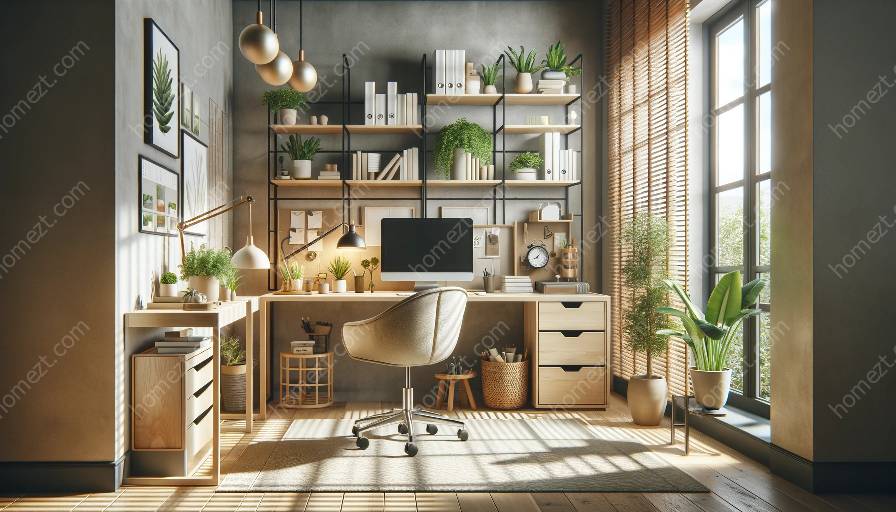Feng Shui is an ancient Chinese practice that focuses on creating harmonious environments by arranging furniture, decor, and other elements in a way that maximizes energy flow. When it comes to home office and study room design, applying Feng Shui principles can greatly enhance the overall atmosphere and productivity of the space. In this topic cluster, we will explore the practical applications of Feng Shui in home office design and study room layout. We will also delve into interior design and styling tips to create a cohesive and inspiring workspace.
Understanding Feng Shui in Home Office Design
Feng Shui is rooted in the belief that the arrangement of physical objects can impact the flow of energy, or chi, in a particular space. When it comes to designing a home office or study room, the goal is to create a space that promotes concentration, creativity, and productivity while also fostering a sense of calm and balance.
Organizing Space According to Feng Shui
One of the fundamental principles of Feng Shui is decluttering and organizing the space to allow for the smooth flow of energy. In a home office or study room, this can be achieved by keeping the space tidy and free from unnecessary clutter. By organizing items such as books, papers, and office supplies, you can create a sense of order and clarity, which is essential for maintaining focus and efficiency.
Maximizing Natural Light and Air Flow
Feng Shui also emphasizes the importance of natural light and ventilation in a space. When designing a home office, consider positioning your desk or work area near a window to take advantage of natural light. This not only enhances the overall ambiance of the room but also helps to create a sense of connection to the outdoors, which can be rejuvenating and uplifting. Additionally, ensuring good air circulation within the space is important for maintaining a healthy and invigorating environment.
Optimizing Furniture Layout and Placement
The arrangement of furniture in a home office or study room plays a crucial role in the application of Feng Shui principles. It is recommended to place the desk in a commanding position, where you have a clear view of the door and windows while seated. This allows for a sense of security and control, promoting a confident and focused mindset. Additionally, incorporating ergonomic and comfortable seating can contribute to the overall well-being and productivity of the workspace.
Choosing a Harmonious Color Scheme
Color plays a significant role in Feng Shui, as different hues can evoke specific emotions and energies. When selecting a color scheme for your home office or study room, consider the psychological effects of different colors. For example, calming blues and greens can promote a sense of peace and tranquility, while vibrant yellows and oranges can energize and stimulate creativity. Balancing the use of colors in the space can create a harmonious and revitalizing environment.
The Connection between Feng Shui and Interior Design
Integrating Feng Shui principles with interior design and styling can result in a well-balanced and visually appealing home office or study room. Paying attention to the layout, decor, and overall aesthetics of the space can further enhance the positive energy flow and functionality of the workspace.
Adding Elements of Nature and Inspiration
Incorporating natural elements, such as plants, stones, or water features, can introduce a sense of vitality and connection to nature within the space. These elements not only contribute to the aesthetic appeal of the room but also serve to balance and enrich the energy flow. Furthermore, displaying inspirational artwork, meaningful quotes, or personal mementos can infuse the space with motivation and positivity.
Striking the Right Balance with Furniture and Decor
When styling a home office or study room, aim for a balance between functionality and aesthetics. Selecting furniture pieces that are both practical and visually pleasing can create a workspace that is both conducive to productivity and inviting. Incorporating tasteful decor accents, such as rugs, lighting fixtures, and storage solutions, can further elevate the overall design and ambiance of the room.
Conclusion
By integrating the principles of Feng Shui with home office design and study room layout, you can create a space that not only enhances productivity and creativity but also fosters a sense of harmony and balance. Paying attention to the organization of space, the placement of furniture, and the use of colors can significantly impact the overall energy flow and atmosphere of the workspace. Additionally, combining these principles with interior design and styling techniques can result in a visually captivating and inspiring home office or study room.


























